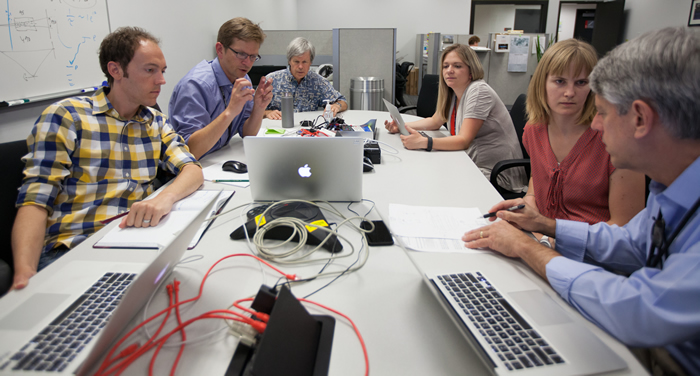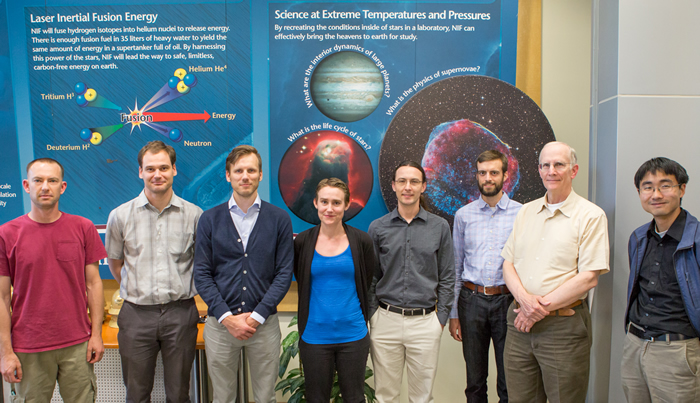Developing the Workforce

Training Future Science Stars
For NIF & Photon Science, stewardship means attracting, training, and retaining future generations of scientists, engineers, programmers, technicians, and other skilled workers by constantly challenging them to solve hard problems, so they’re always ready to support the Laboratory’s important missions.
“The training of scientists through the study of HED physics is an excellent contribution to the STEM (science, technology, engineering, and math) workforce. These individuals gain fundamental, interdisciplinary knowledge of extreme states of matter using the most advanced technical systems that exist.”
From facility tours, to our highly competitive summer student program, to our postdoctoral scholar appointments, NIF is training the future science stars who will continue the nation’s leadership in science and technology.
For example, NIF experiments help maintain the skills of nuclear weapons scientists and train the next generation of experts to maintain the nation’s nuclear stockpile (see NIF and Stockpile Stewardship).
An especially valuable source of next-generation stewardship scientists is through NIF’s collaborations with universities in its Discovery Science (DS) program. Making NIF available to outside researchers not only provides opportunities for advancing basic science; it also serves as career development and an opportunity to engage in innovative high energy density (HED) science for NIF scientists, who spend most of their time performing experiments in pursuit of long-range national security goals.
 Members of the “Gbar” (gigabar, or one million Earth atmospheres) Discovery Science team plan their experiments to measure the equation of state (EOS) at extreme pressures by using streaked radiography of spherical implosions of solid plastic spheres (see “Record EOS Measurements Shed Light on Stellar Evolution”). The Gbar Campaign was initiated by Roger Falcone and his students and postdocs at UC Berkeley, other NIF academic users, and early career scientists from LLNL. From left: Benjamin Bachmann, Tilo Döppner, Joe Nilsen, and Annie Kritcher of LLNL and Alison Saunders and Falcone of UC Berkeley. Like many other students who have worked on NIF & Photon Science projects, Saunders has since joined LLNL as a staff scientist. Credit: Jason Laurea
Members of the “Gbar” (gigabar, or one million Earth atmospheres) Discovery Science team plan their experiments to measure the equation of state (EOS) at extreme pressures by using streaked radiography of spherical implosions of solid plastic spheres (see “Record EOS Measurements Shed Light on Stellar Evolution”). The Gbar Campaign was initiated by Roger Falcone and his students and postdocs at UC Berkeley, other NIF academic users, and early career scientists from LLNL. From left: Benjamin Bachmann, Tilo Döppner, Joe Nilsen, and Annie Kritcher of LLNL and Alison Saunders and Falcone of UC Berkeley. Like many other students who have worked on NIF & Photon Science projects, Saunders has since joined LLNL as a staff scientist. Credit: Jason Laurea By devoting a nominal portion of their time to DS projects, NIF scientists stay current on cutting-edge science and experimental techniques, which in turn keeps their thinking nimble and leads to publication in high-impact journals.
In addition, NIF’s academic users are innovative thinkers and future leaders in the scientific community—just the sort of people with whom LLNL would wish to form lasting relationships.
 Members of a Discovery Science team studying stellar and Big Bang nucleosynthesis via experiments on NIF (from left): Charles Yeamans (LLNL), Daniel Sayre (LLNL), Matthias Hohenberger (Laboratory for Laser Energetics, University of Rochester), Maria Gatu Johnson (MIT), Daniel Casey (LLNL), Alex Zylstra (Los Alamos National Laboratory), Bruce Remington (LLNL), and Hong Sio (MIT). Indiana University and Ohio University also are participating in the campaign.
Members of a Discovery Science team studying stellar and Big Bang nucleosynthesis via experiments on NIF (from left): Charles Yeamans (LLNL), Daniel Sayre (LLNL), Matthias Hohenberger (Laboratory for Laser Energetics, University of Rochester), Maria Gatu Johnson (MIT), Daniel Casey (LLNL), Alex Zylstra (Los Alamos National Laboratory), Bruce Remington (LLNL), and Hong Sio (MIT). Indiana University and Ohio University also are participating in the campaign. While encouraging potential new hires to pursue careers at the Laboratory, LLNL also benefits from its ability to offer continued access to leading-edge research. All LLNL scientists who assist Discovery Science users do so voluntarily.
In the decade since the inception of the fundamental science program, more than a dozen scientists who brought projects to the program while in graduate school have joined Lawrence Livermore, Los Alamos, and Sandia national laboratories—clear evidence that the program provides a success path between top academic institutions and the labs.



